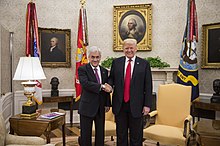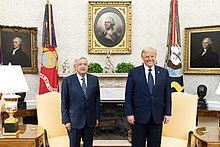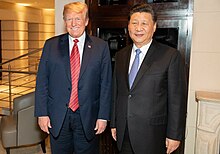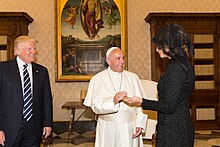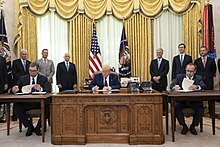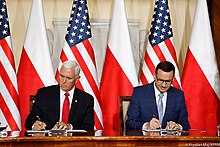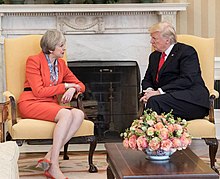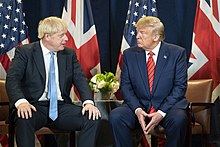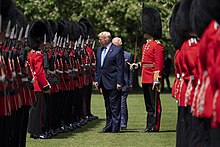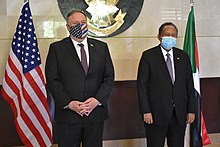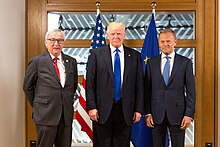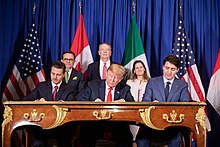Foreign policy of the first Donald Trump administration
U.S. foreign policy during the first presidency of Donald Trump was noted for its unpredictability and reneging on prior international commitments,[1][2][3][4] upending diplomatic conventions, embracing political and economic brinkmanship with most adversaries, and stronger relations with traditional allies.
[26] As part of the "America First" policy, Trump's administration reevaluated many of the U.S.'s prior multinational commitments, including withdrawing from the Trans-Pacific Partnership, the INF Treaty, the UNHRC and UNESCO, and the Paris Agreement, and urging NATO allies to increase financial burden sharing.
[58] On July 16, 2018, Trump and Russian President Vladimir Putin met in Helsinki for a two-hour meeting to discuss the Syrian civil war, the Intermediate-Range Nuclear Forces Treaty, and Russia's encroachment on Ukraine.
[79][80] Several of the normalization agreements involved diplomatic incentives offered by the U.S., which took steps to remove Sudan from the U.S.'s state sponsors of terrorism list, to recognize Moroccan sovereignty over the disputed region of Western Sahara, and to sell F-35 stealth fighter jets to the UAE.
[81][82] A normalization agreement between Bahrain and Israel was signed in September 2020, providing for diplomatic relations (exchanging ambassadors and opening embassies), the establishment of direct flights, and cooperation in health care, technology, agriculture, and other mutual industries.
[111] Trump called President Sebastián Piñera in January 2018, months before his return to La Moneda Palace and talked about the Chile–United States Free Trade Agreement, the tax reform approved by the U.S. Senate, the 2017–2018 Iranian protests, and especially on the Crisis in Venezuela.
[194][195] On July 9, 2020, the Trump administration imposed sanctions and visa restrictions against senior Chinese officials, including Chen Quanguo, Zhu Hailun, Wang Mingshan (王明山) and Huo Liujun (霍留军).
[208] On August 13, 2020, U.S. Department of State designated the Confucius Institute U.S. Center as a foreign mission of the PRC, "recognizing CIUS for what it is: an entity advancing Beijing's global propaganda and malign influence campaign on U.S. campuses and K-12 classrooms.
"[243] A January 2019 American intelligence community assessment found that North Korea was unlikely to relinquish its nuclear arsenal, directly contradicting a core tenet of Trump's stated foreign policy.
This plan, aimed at easing the sanctions imposed on Russia, progressed from Putin and his advisors to Ukrainian politician Andrey Artemenko, Felix Sater, Michael Cohen, and Flynn, where he would have then presented it to Trump.
[326] In February 2017, following his first meeting with his Russian counterpart Sergey Lavrov, Secretary of State Rex Tillerson said that the U.S. expected Russia to "honor its commitment to the Minsk agreements and work to de-escalate the violence in Ukraine".
News reported in June 2017 that during the early weeks of the Trump administration, State Department employees were told to develop proposals to lift the sanctions which had been imposed on Russia after its military incursions into Ukraine and its interference in the November election.
According to the book The Madman Theory by CNN anchor Jim Sciutto, Susan M. Gordon the former Principal Deputy Director of National Intelligence stated that Trump downplayed Russian interference in the 2016 Presidential election and refused to devote the necessary resources to defend against it in the future.
[359][362][363] After the National Security Council convened a meeting on the matter in late March 2020, the White House officials were presented with a number of options, including making a diplomatic protest and imposing sanctions, but Trump did not authorize any action.
[364][365][366] On July 1, 2020, following media reports of Taliban participation in an alleged Russian bounty program, the House Armed Services Committee overwhelmingly voted in favor of an amendment to the National Defense Authorization Act for Fiscal Year 2021 (2021 NDAA) to restrict Trump's ability to withdraw U.S. troops from Afghanistan.
[379] On September 25, the administration released the White House's five-page, declassified memorandum of the July 25 phone call, which shows Trump repeatedly pressing Zelensky to work with Giuliani and U.S. Attorney General William Barr on investigations into the Biden family as well as the cybersecurity company CrowdStrike.
[439][440] Trump's statements caused criticism and controversy, as most legal experts agreed that the action would be an illegal war crime under the Geneva Conventions and because many believed that it would increase support for Islamic fundamentalism across the Middle East.
[475] With the arrival of the Trump administration, a change in policy was instituted regarding the disclosure of troop levels abroad as well as the timing of any additional deployments to the Middle East, following through on his campaign promises to utilize the "element of surprise".
Similar to their reaction to Trump's initial December 2018 withdrawal announcement, Pentagon officials claimed they were "completely blindsided" by the order and drew concerns about the apparent sudden reneging of the U.S.'s alliance with the Syrian Kurds.
"[514] Trump defended his withdrawal order, stating that the Kurdish-Turkish conflict "has nothing to do with us" and described the situation as "strategically brilliant" for the U.S.[515] According to Jim Sciutto's book The Madman Theory, the former Deputy Secretary of Defense for the Middle East Mick Mulroy said that the decision ran contrary to one of the main tenants of the National Defense Strategy of building and maintaining partners, that the YPG elements of the SDF were only ones capable of providing the combat leadership needed to defeat ISIL, and that the Commander of the SDF, General Mazloum Abdi, sent a letter to U.S. service members essentially absolving them of the decision of Trump, as he knew they would never have abandoned them.
[565] In September 2020, the United States suspended part of its economic assistance to Ethiopia due to the lack of sufficient progress in negotiations with Sudan and Egypt over the construction of the Grand Ethiopian Renaissance Dam.
[584] In a 60-minute interview in mid-January 2017, with Michael Gove of the Times of London and Kai Diekmann of Bild, U.S. president Donald Trump criticized the European Union as "basically a vehicle for Germany" claiming that it was a "very catastrophic mistake" on Angela Merkel's part to admit a million refugees – whom he refers to as "illegals".
[587] The relation soured even more when Jean-Claude Juncker jokingly said it would support the independence of the US State of Ohio and the city of Austin, Texas after Donald Trump backed the Brexit and encouraging other European countries to follow its example.
Trump's nationalist sentiments had already strained relations with several EU countries and other American allies, to the point where after a NATO summit, Merkel said that Europeans cannot rely on United States' help anymore.
[620] Canadian writer Lawrence Solomon describes Trump's position on trade as similar to that as of pre-Reagan Republican presidents, such as Herbert Hoover (who signed the Smoot-Hawley Tariff Act) and Richard Nixon (who ran on a protectionist platform).
[citation needed] After taking office, White House press secretary Sean Spicer noted that Trump was considering imposing a 20 percent tariff on Mexican imports to the United States as one of several options that would pay for his proposed border wall.
[626] Trump pledged "swift, robust and unequivocal" action against Chinese piracy, counterfeit American goods, and theft of U.S. trade secrets and intellectual property, and condemned China's "illegal export subsidies and lax labor and environmental standards.
[638][639] In the early years of his presidency, Trump sought to shift authority over military operations back to the Pentagon by loosening rules of engagement and reducing White House oversight in the chain of command, a departure from his predecessor.
[640] In 2020, Mother Jones reported that, under Trump, "the US military was pursuing a strategy that tolerated a higher risk of bloodshed..." in Afghanistan and that from 2016 to 2019, the number of Afghan civilians killed by international airstrikes increased by 330 percent.
In December 2020, the Trump administration ordered AFRICOM to withdraw 700 U.S. troops from Somalia, dispersing them to other East African countries such as Kenya and Djibouti; U.S. drone strikes and cooperation with Somali forces were expected to continue.




